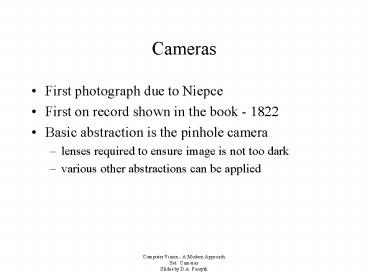Computer Vision - A Modern Approach - PowerPoint PPT Presentation
Title:
Computer Vision - A Modern Approach
Description:
supermarket tabloids are a great source. Computer Vision - A Modern Approach. Set: Cameras ... Where parallel planes intersect ... – PowerPoint PPT presentation
Number of Views:33
Avg rating:3.0/5.0
Title: Computer Vision - A Modern Approach
1
Cameras
- First photograph due to Niepce
- First on record shown in the book - 1822
- Basic abstraction is the pinhole camera
- lenses required to ensure image is not too dark
- various other abstractions can be applied
2
Pinhole cameras
- Abstract camera model - box with a small hole in
it
- Pinhole cameras work in practice
3
Distant objects are smaller
4
Parallel lines meet
Common to draw film plane in front of the focal
point. Moving the film plane merely scales the
image.
5
Vanishing points
- each set of parallel lines (direction) meets at
a different point - The vanishing point for this direction
- Sets of parallel lines on the same plane lead to
collinear vanishing points. - The line is called the horizon for that plane
- Good ways to spot faked images
- scale and perspective dont work
- vanishing points behave badly
- supermarket tabloids are a great source.
6
(No Transcript)
7
The equation of projection
8
The equation of projection
- Cartesian coordinates
- We have, by similar triangles, that
(x, y, z) -gt (f x/z, f y/z, -f) - Ignore the third coordinate, and get
9
Homogenous coordinates
- Add an extra coordinate and use an equivalence
relation - for 2D
- equivalence relationk(X,Y,Z) is the same as
(X,Y,Z) - for 3D
- equivalence relationk(X,Y,Z,T) is the same as
(X,Y,Z,T)
- Basic notion
- Possible to represent points at infinity
- Where parallel lines intersect
- Where parallel planes intersect
- Possible to write the action of a perspective
camera as a matrix
10
The camera matrix
- Turn previous expression into HCs
- HCs for 3D point are (X,Y,Z,T)
- HCs for point in image are (U,V,W)
11
Weak perspective
- Issue
- perspective effects, but not over the scale of
individual objects - collect points into a group at about the same
depth, then divide each point by the depth of its
group - Adv easy
- Disadv wrong
12
Orthographic projection
13
The projection matrix for orthographic projection
14
Pinhole too big - many directions are
averaged, blurring the image Pinhole too
small- diffraction effects blur the
image Generally, pinhole cameras are dark,
because a very small set of rays from a
particular point hits the screen.
15
The reason for lenses
16
The thin lens
17
Spherical aberration
18
Lens systems
19
Vignetting
20
Other (possibly annoying) phenomena
- Chromatic aberration
- Light at different wavelengths follows different
paths hence, some wavelengths are defocussed - Machines coat the lens
- Humans live with it
- Scattering at the lens surface
- Some light entering the lens system is reflected
off each surface it encounters (Fresnels law
gives details) - Machines coat the lens, interior
- Humans live with it (various scattering
phenomena are visible in the human eye) - Geometric phenomena (Barrel distortion, etc.)
21
Camera parameters
- Issue
- camera may not be at the origin, looking down the
z-axis - extrinsic parameters
- one unit in camera coordinates may not be the
same as one unit in world coordinates - intrinsic parameters - focal length, principal
point, aspect ratio, angle between axes, etc.
22
Camera calibration
- Issues
- what are intrinsic parameters of the camera?
- what is the camera matrix? (intrinsicextrinsic)
- General strategy
- view calibration object
- identify image points
- obtain camera matrix by minimizing error
- obtain intrinsic parameters from camera matrix
- Error minimization
- Linear least squares
- easy problem numerically
- solution can be rather bad
- Minimize image distance
- more difficult numerical problem
- solution usually rather good,
- start with linear least squares
- Numerical scaling is an issue
23
Geometric properties of projection
- Points go to points
- Lines go to lines
- Planes go to whole image
- Polygons go to polygons
- Degenerate cases
- line through focal point to point
- plane through focal point to line
24
Polyhedra project to polygons
- (because lines project to lines)
25
Junctions are constrained
- This leads to a process called line labelling
- one looks for consistent sets of labels, bounding
polyhedra - disadv - cant get the lines and junctions to
label from real images
26
Curved surfaces are much more interesting
- Crucial issue outline is the set of points where
the viewing direction is tangent to the surface - This is a projection of a space curve, which
varies from view to view of the surface































